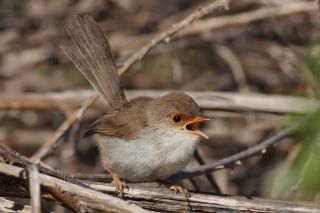Animal Behavior
Why Do Female Birds Sing?
Female birdsong is functionally distinct from male song.
Posted September 3, 2024 Reviewed by Gary Drevitch
Key points
- Although females sing in two-thirds of songbird species, the function of female song is not well understood.
- The most studied and supported function of female song is territorial defense.
- Female song also likely functions in intrapair communication and female-female competition.
- Unlike male birdsong, female song does not appear to function widely in mate attraction.

Traditionally, birdsong has been viewed as a male trait, and this bias has dominated research on the behavior.
“For a long time, scientists thought that female birds didn’t sing,” says Cristina Barros, a Ph.D. student at the University of Northern Colorado. “If they did observe a female bird singing, they would label the behavior aberrant, caused by a hormone imbalance or some other anomaly.”
Research from the last few decades paints a different picture of songbirds. Recent work suggests that female song was the norm for the ancestors of modern songbirds. And many female birds still sing today: It is estimated that female song occurs in about two-thirds of all songbird species.
Despite the increased documentation of female birdsong in recent years, questions remain about its function, says Barros. Male songbirds use song most often to attract mates and defend territories. Why do females sing?
Female Song Functions
With her advisor, Lauryn Benedict, Barros conducted a review of the female birdsong literature from 1900 through 2022, looking for studies that addressed song functions.
_0.jpg?itok=Q6mn0KrK)
In total, they reviewed 147 articles on 88 bird species where female song function was studied. In contrast to male birds, females do not appear to use song for mate attraction very much. Rather, Barros and Benedict found the highest support for territorial defense (67% of the studies analyzed), followed by intrapair communication (45% of studies) and female-female competition (43% of studies). Parent-offspring communication was another potential song function, but it was not often supported or tested for in the studies.
Barros says that the high level of support for territorial defense may be influenced by the ease of testing for that function: Researchers can simply broadcast a simulated intruder in a bird’s territory and see if it responds.
“That being said, I do think it make sense that we're finding more species where female birdsong function is tied to territorial defense rather than mate attraction,” she says. “Females often invest so much in making and laying the eggs, as well as incubating them, so they have a lot to lose, in terms of territory and protecting their nest.”
-_Female_calling_in_the_rain_at_Kolkata_I_IMG_3836_0.jpg?itok=ud7_DjAI)
The second-highest-supported function for female song, intrapair communication, is essential for pair-bonded species that cooperate to collectively defend a territory and/or coordinate caretaking of offspring.
Female song may also often function in competition or aggression between females, most often in socially monogamous species. “If the male contributes a lot to helping feed the chicks or defend the territory, then females are highly motivated to make sure he’s not busy in some other lady’s bed, so to speak,” says Barros.
More to Learn
In addition to identifying the functions of female song with the most experimental support, Barros and Benedict noted remaining gaps in knowledge.
For example, they did not find a lot of support for female song functioning in parent-offspring communication, but it was also the least tested potential function. Barros says that female birds spend a lot of time singing in the nest or in the vicinity of the nest. It is not fully understood if their song is directed at their offspring or if chicks eavesdrop on their mothers’ song.
_0.jpg?itok=Q6mn0KrK)
Additionally, Barros and Benedict were surprised to find that less than 10% of studies attempted to link female song to reproductive success or other proxies of fitness. They suggest that future studies should include tests of fitness correlates of female birdsong function.
While the increasing scientific interest in female birdsong is encouraging, it is apparent that there is a lot more to learn about which female songbirds sing and why.
“We may think we know a lot about songbird species, but including females is really important,” says Barros. “If you only investigate one sex in a species, you’re literally getting only half the story.”
References
Barros CM, Benedict L, and Sanchez KA. 2024. A review of the literature on female birdsong function. Animal Behaviour 216: 23-35. Doi: 10.1016/j.anbehav.2024.07.018.


